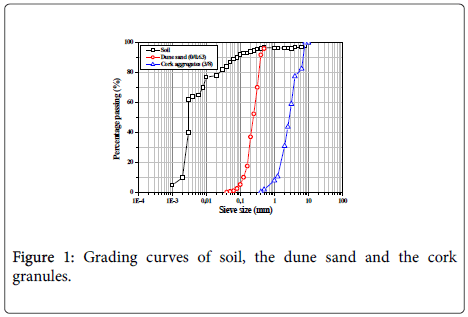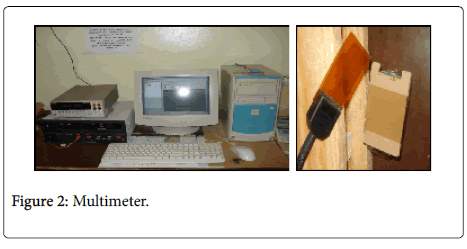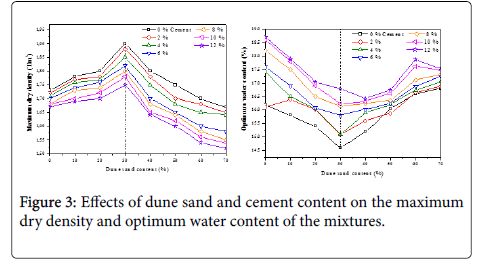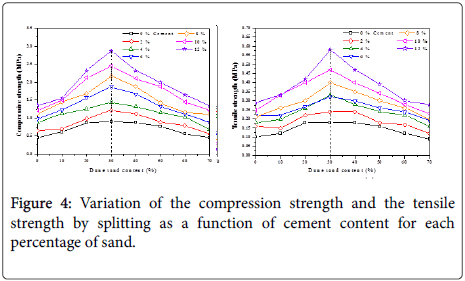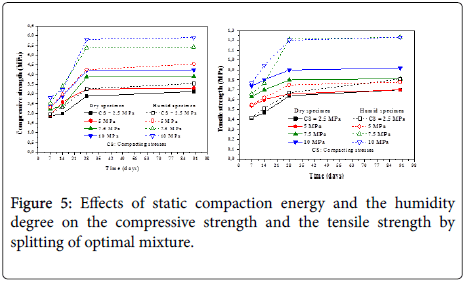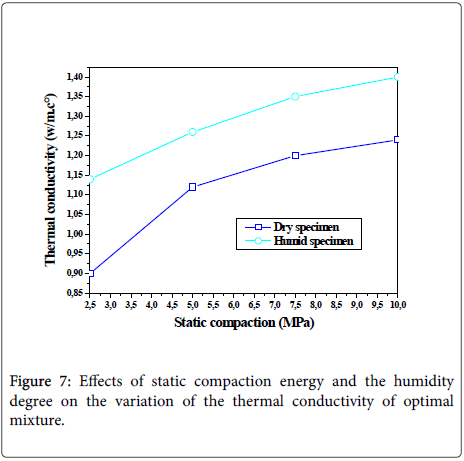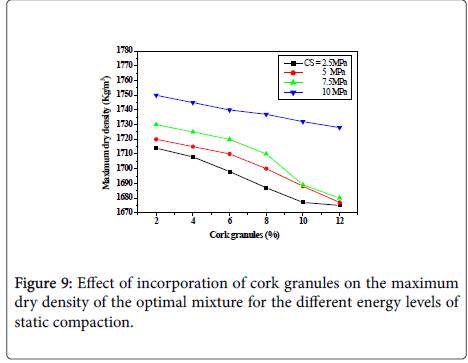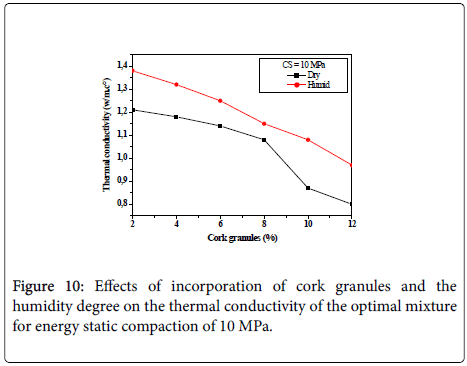Research Article Open Access
Properties of the Compressed-Stabilized Earth Brick Containing Cork Granules
Salim Guettala1,3 *, Mohamed Bachar1and Lakhdar Azzouz2
1Civil Engineering Department, University of Djelfa, 17000 Djelfa, Algeria
2Civil Engineering Department, University of Laghouat, 03000 Laghouat, Algeria
3Civil Engineering Research Laboratory, University of Biskra, 07000 Biskra, USA
- *Corresponding Author:
- Guettala S
Civil Engineering Research Laboratory
University of Biskra
07000 Biskra, USA
Tel: 713 33 54 31 60
E-mail: guettalasalim@yahoo.com
Received date: Apr 28, 2016; Accepted date: May 18, 2016 ; Published date: May 24, 2016, 2016
Citation: Guettala S, Bachar M, Azzouz L (2016) Properties of the Compressed-Stabilized Earth Brick Containing Cork Granules. J Earth Sci Clim Change 7:353. doi: 10.4172/2157-7617.1000353
Copyright: © 2016 Guettala S, et al. This is an open-access article distributed under the terms of the Creative Commons Attribution License, which permits unrestricted use, distribution, and reproduction in any medium, provided the original author and source are credited.
Visit for more related articles at Journal of Earth Science & Climatic Change
Abstract
This paper investigates the mechanical properties and thermal conductivity of the compressed-stabilized earth brick containing cork granules. First part of paper highlights the influence of mass percentage of cement and dune sand on maximum dry density, the optimal water content and mechanical strengths. The results show that composition (58% soil, 30% dune sand, 12% cement) assures maximum dry density of 1.75 T/m3 with a compressive strength in the dry state of 2.87 MPa at 28 days. Then a test of static compaction is performed on this composition for four levels of applied stresses. The results show that compaction of 10 MPa has increased maximum dry density a rate of 0.23%, which corresponds to rate of increase of the compression strength in the dry state of 46.69%. Second part examines the effect of the addition of the cork granules in mass relative to the dry soil and which is suffered a the static compaction with the different applied stresses levels on the mechanical properties, maximum dry density and thermal conductivity of optimized mixture. The results indicate that for a static compacting of 10 MPa and 12% of cork granules, the dry density decreases an rate of 1.50%, the compressive strength in the wet state decreases an rate of 7.41% at 28 days and the thermal conductivity in the dry state significantly decreases an rate of 55% relative to optimized mixture without the incorporation of the cork granulates which improves therefore thermal insulation.
Keywords
Compressed-stabilized earth brick; Cork granules; Compression strength; Tensile strength; Maximum dry density; Thermal conductivity
Introduction
We need to find alternative local low cost building materials which do not require special skills, special machines, equipment for their production and where traditional experience by local populations is available. Soil based construction blocks have been used in North Africa for centuries, especially in rural regions and in the desert. Soil could be stabilized either by manual compaction, mechanical compaction or natural fibers [1]. It has many environmental, social and cultural benefits. Cement stabilization of soil began with a trial basis in 1917 and since then, several works have been published [2-13]. Most of them focus on improving their strength and durability characteristics, applicable in road construction technology as well as manufacturing of building bricks. Several factors, affecting the strength of cement stabilized soils have been studied, namely the type of stabilizer and additives, genetic origin, mineralogical and chemical composition. When clay soil is blended with cement in the presence of water, hydration reaction will take place. The compound of C3S and C2S present in the cement react with water forming complex calcium silicate hydrates C-S-H gel [14]. C-S-H gel has beneficial effect in clay material by reduction of deleterious heaving effects such as the growth of ettringite due to the rapid removal of alumina. The formation of ettringite contributes to the increase of porosity and simultaneously decreases the free moisture content. The C-S-H gel formed fill the void spaces and bind the soil particles together thus imparting strength to the soil mixture [15]. The increase of the cement content increases the compressive strength because the hydration products of the cement fill in the pores of the matrix and enhance the rigidity of its structure by forming a large number of rigid bonds in the soil. These links linking the clay particles together could be attributed to the cementitious reaction products such as calcium silicate hydrates C-S-H, calcium aluminate hydrates C-A-H and calcium aluminosilicate hydrates C-AS- H [1,16,17]. As the cement content increases, the cement content per grain contact point increases and upon hardening, imparts a commensurate amount of bonding at the contact points. Beyond this zone, the strength development slows down with gradual increase. The incremental gradient becomes nearly zero and does not make any further significant improvement. The zone is referred to as the transitional zone. The considerable strength increase appears again when cement content is significantly high [7,8]. The compressive strength obtained after 7 days of curing was about 70% of that obtained after 28 days of curing for up to 10% of cement content. The higher cement content than 10% need a period of curing of 21-28 days for the complete strength to be developed. The tensile strength increased with the increasing of cement content in a similar trend to that observed with the compressive strength [1,16].
Guettala et al. [18], shows that the compressive strength of dry and humid sand-soil samples increases with increasing the sand content. However, in percentage terms, the compressive strength evolution is 30% for dry samples and 36% for humid samples, when the concentration of sand is 30%. Venkatarama et al. [19], shows that the compressive strength of compacted cement stabilised soil is sensitive to dry density. Strength increases with increase in density irrespective of the moulding water content and cement content. Commonly, most researchers found that the density of compressed stabilized earth bricks is within the range of 1500 to 2000 kg/m3. Density of the compressed earth brick is consistently related to its compressive strength and compactive force applied during production. The dry density is largely a function of the constituent material’s characteristics, moisture content during pressing and the degree of compactive load applied and even compressive strength is controlled by density. Various studies [6,12] have been published where a suitable value of the compaction pressure of specimens has been assumed from 10 to 30 MPa for laterite and lateritic soils. In some cases, specimens were compacted in the Proctor mould at the optimal water content. Types of compaction applied such as dynamic, static and vibro will also affect the density. The density of brick can be determined through standard procedure such as ASTM C 140 and BS 1924-2 (1990) and others [1,15,20,21].
The compressive strength and the dry density increased with the increase in the applied static stress [1,16]. Compacting procedure also affect considerably on the compressive strength of the brick Guettala et al. [18], concluded that by increasing the compacting stress from 5 to 20 MPa, it will improve the compressive strength up to 70%. His conclusion was strengthened by Bahar et al. [1], observed that by using dynamic compaction energy dry compressive strength increases by more than 50% but for vibro-static compaction increases slightly for about 5%. Thermal comfort in building materials is an important aspect that attracts great attention nowadays since building regulations nowadays stressing more on the thermal performance of the buildings compare to the past. As a building material, brick has quite excellent thermal conductivity. Oti et al. [15], observed that thermal conductivity is a function of the material density and moisture content. Compressed stabilized earth bricks showed better thermal conductivity value compare to the fired clay bricks. Moisture contents affect strength development and durability of the material and have a significant influence on the long term performance of stabilized soil material especially has an effect on bonding with mortars at the time of construction. When the brick is dry, water is rapidly sucked out of the mortar preventing good adhesion and proper hydration of the cement and when the brick is very wet the mortars tends to float on the surface without gaining proper adhesion [15,21]. For improving the thermal comfort and the energy savings, it is necessary to implement particularly efficient materials, providing good thermal insulation. Indeed, good thermal insulation leads to the choice of cooling less powerful equipment therefore more economical. Bahar et al. [1], noted that the addition of cement and sand content can decrease slightly the conductivity of the brick. The higher conductivity for low cement contents could be attributed to the low consumption of mixing water by hydration for low cement contents and hence to the higher quantity of available conductible free water. A wet specimen has a higher thermal conductivity than a dry specimen [1,16]. In the same way Meukam et al. [22,23], shows that the thermal conductivity increases with the natural water content of the mixture. Indeed increasing the humidification of the materials translates into a gradual replacement of the air pores by water. The thermal conductivity of water (about 0.54 w/m.k) is much greater than that of air (about 0.02 w/m.k) at the same temperature, therefore the humidifying leads to increased thermal conductivity of the materials studied. The advantage of having low thermal conductivity can result in energy efficiency, cost reduction of heating in winter and air conditioning in summer, and environmental friendly of a building. Before needs increasing of resource in materials,the requirements of environmental protection in a vision of sustainable development, it has become necessary to explore all possibilities of reuse and recovery of waste and the use of materials in abundance as soil, dune sand and cork granules in earth construction. Cork is a natural, renewable resource and has unique properties which differ from other lignocellulosic materials. The main byproducts of the cork industry, cork powder and granules, can be valorized with an application on environmental adsorption technologies, as two benefits can be drawn simultaneously: waste recycling and water, waste water or air purification [24]. Due to their lightness and resistance to moisture, they can present a technical solution in the building sector [25]. Several studies have been made on incorporating cork aggregates in cement and plaster to obtain a composite thermally insulating material [26-28]. Based on the experiments reported by Castro et al. [29], the concrete blocks containing cork were reported to reduce the thermal conductivity by 45% of concrete blocks without cork and in addition reduced the CO2 emissions associated with the block wall well as makes the lighter and easier to handle. Therefore, the low density of the cork granules could be exploited to make lightweight cementitious composites. In addition to the low density, there are other advantages associated with the cork caused by its cellular structure and chemical composition. These advantages include: low thermal conductivity, good sound absorption, and water resistance [30]. The thermal conductivity of concrete-cork composites decreases, as the concrete density decreases. A 46% greater thermal resistance was measured for concrete-cork composites containing 20% cork in comparison to the concrete without cork granules. Panesar et al. [31], shows that the thermal conductivity is controlled by the percentage of cork used which is attributed to the direct relationship observed between cork density and the concrete-cork composite density. In the same context, these results are confirmed by Ana Brás et al. [32], indicate that the microstructural analyses show that the mechanical properties of cement-cork blend are not only controlled by cork’s low density, but also by interaction of cork extractives with the cement hydration process. Thermal conductivity presents a linear decrease for an increasing cork dosage in mortars. This work is part of the promotion of local products such as soil, dune sand and waste from the manufacture of agglomerated expanded cork primarily designed for thermal insulation. Industrial wastes now raise particularly difficult issues. Or reuse could solve three problems: economic problems, technical and environmental. The present paper therefore is aimed at studying the influence of the addition of the cork granules on the mechanical properties, maximum dry density and thermal conductivity of the cement-stabilized compressed earth blocks.
Experimental Program
Here are the presented materials used, testing method, proportions of mixtures, the specimen’s preparation and tests conducted.
Materials
The soil used in this investigation was sourced from the Djelfa region was first passed through a 5 mm sieve before being characterized. Table 1 summarises the characteristics of the soil used. Figure 1 gives the grading curve of the soil used. Composite cement (CEM II/B) class 42.5 MPa with 35% to limestone fillers was used for the chemical stabilization of soil. The clinker is from the cement factory of M’sila. The chemical analysis of clinker shows that it is in conformity with standard NFP 15-301. The chemical and mineralogical compositions of clinker are presented in Tables 2 and 3, respectively. The sand used was fine dune sand passing a 0.63 mm sieve from the Djelfa region. Table 4 also shows some physical characteristics of the studied dune sand. The grading curve of dune sand is given in Figure 1. Cork granules from waste in sawing plate’s compressed cork at the factory located in Jijel region, these wastes are then separated according to the different sizes using sieves. Table 5 shows some characteristics of the studied cork granules. The grading curve of the cork granules 3/8 mm is given in Figure 1. The water is drinking water that contains little sulfate and having a temperature of 20 ± 2°C. Its quality conforms to the requirements of NFP 18-404 standard.
| Property | ||
|---|---|---|
| Atterberg’s limits | Liquid limit WL Plasticity index Ip |
70.4 43.2 |
| Grain size distribution | Gravel (>4.75 mm) (%) Sand (0.074-4.75 mm) (%) Clay and silt (<0.074 mm) (%) |
2.3 6.4 91.3 |
| Chemical characteristics | Iron oxide-alumina (%) (Fe2O3 - Al2O3) Carbonate CaCO3 (%) Chloride NaCl (%) SulphatesCaSO4 (%) Insoluble residue I.R (%) |
14.6 33.0 0.15 0.20 42.2 |
| Normalized Proctor test | Optimum water content (%) Maximum dry density (kN/m3) |
9.0 16.8 |
| Sand equivalent | By piston test (%) By sight (%) |
14.8 17.6 |
Table 1:Characteristics of the soil used.
| SiO2 | Al2O3 | Fe2O3 | CaO | MgO | SO3 | Na2O | K2O | Cl | LOI |
|---|---|---|---|---|---|---|---|---|---|
| 17.49 | 4.51 | 3.02 | 62.78 | 2.15 | 2.38 | 0.05 | 0.64 | 0.02 | 8.10 |
LOI: Loss on ignition.
Table 2: Chemical composition of clinker (%).
| C3S | C2S | C3A | C4AF |
|---|---|---|---|
| 55.41 | 13.65 | 2.25 | 14.83 |
Table 3: Mineralogical composition of clinker (%).
| Fineness modulus | Apparent density (kg/m3) |
Specific density (kg/m3) |
Porosity (%) |
Sand equivalent | |
|---|---|---|---|---|---|
| By sight (%) | By piston test (%) | ||||
| 1.13 | 1491.13 | 2517 | 41 | 97.58 | 96.58 |
Table 4: Physical characteristics of dune sand (0/0.63 mm).
| Thermal conductivity (w/m.k) | Apparent density (kg/m3) |
Specific density (kg/m3) |
Porosity (%) |
Absorption (%) |
|---|---|---|---|---|
| 0.036 | 71 | 145 | 51 | 2.3 |
Table 5: Characteristics of cork granules (3/8 mm).
Testing method, proportions of mixtures and the specimens preparation
An experimental program was carried out to studying in parallel the effect of different percentages of dune sand 0%, 10%, 20%, 30%, 40%, 50%, 60% and 70% by mass relative to soil and the influence of the chemical stabilization by cement addition of 0%, 2%, 4%, 6%, 8%, 10% and 12% by mass relative to soil on the physico-mechanical properties of the various mixtures. We have prepared fifty six formulations without compaction and without the incorporation of the cork granules. The details of the mixtures proportions are given in Table 6.
| Mixture (soil - dune sand - cement) | Water (%) | ||||||
|---|---|---|---|---|---|---|---|
| p = 0% cement | 2% | 4% | 6% | 8% | 10% | 12% | |
| (100-p)% S +0% DS + p% C | 16.20 | 16.10 | 17.40 | 17.60 | 18.20 | 18.60 | 18.70 |
| (90-p)% S + 10% DS + p% C | 15.80 | 16.40 | 16.50 | 16.90 | 17.50 | 17.80 | 17.90 |
| (80-p)% S + 20% DS + p% C | 15.40 | 16.02 | 16.05 | 16.08 | 16.50 | 16.90 | 17.05 |
| (70-p)% S + 30% DS + p% C | 14.60 | 15.08 | 15.10 | 15.80 | 16.14 | 16.23 | 16.80 |
| (60-p)% S + 40% DS + p% C | 15.20 | 15.60 | 15.90 | 16.02 | 16.25 | 16.32 | 16.42 |
| (50-p)% S + 50% DS + p% C | 16.05 | 15.88 | 16.20 | 16.26 | 16.36 | 16.62 | 16.74 |
| (40-p)% S + 60% DS + p% C | 16.58 | 16.65 | 16.74 | 16.88 | 17.12 | 17.62 | 17.87 |
| (30-p)% S + 70% DS + p% C | 16.80 | 16.88 | 17.05 | 17.25 | 17.32 | 17.48 | 17.54 |
Table 6: Mixtures proportions.
After this we have determined the optimal composition (soil - dune sand - cement). Subsequently, we studied the influence of the mechanical stabilization by static compaction for four levels of applied stresses 2.5, 5, 7.5 and 10 MPa on the mechanical properties, maximum dry density and thermal conductivity the mixture already optimized in the first part, well as the effect of the curing methods (dry-humid) on the mechanical properties and thermal conductivity of optimized mixture. Finally, we evaluated the effect of the incorporation of the mass contents of the cork granules 2%, 4%, 6%, 8%, 10% and 12% relative to soil on the mechanical properties, maximum dry density and the thermal conductivity. Well as the effect of the curing methods (dry-humid) on the mechanical properties and thermal conductivity of optimized mixture. In this study, the specimens were demoulded 1 min after completion of the compaction and were stored in two environments (in the free air and wet wrapped in thin plastic film). We have thought to the treatment of cork granules before addition in the earth concrete stabilized and compressed. The treatment is a superficial cover to the cement selected from the literature [33]. The cork granules are coated with a cement milk (cement + water) and allowed to dry completely before their use so that the cork granules do not absorb water during incorporation in the cement-stabilized compressed earth blocks.
Tests Conducted
Proctor compaction test
The Proctor test is used to determine the optimal water content that leads to the maximum density. This test uses a soil sample with less than 4.76 mm (sieve n°. 4) to which an increasing water content is added. The soil sample is compressed into three layers with 25 blows per layer. Proctor standard compaction test, according to BS 1377-1990: Part 4 [34] was applied to determine the maximum dry density (MDD) and the optimal water content (OWC) of soil.
Static compaction test
Static compaction is obtained by applying a static pressure. The oedometric mold enables the production of the cylindrical specimens under an axial stress which can vary from 2.5 to 10 MPa. It consists of two half-shells fixed to an outer shaft and two lower pistons (fixed) and upper (mobile). This mold 100×100 mm is movable along its axis independently of the two pistons to ensure compaction symmetrical relative to the median plane and horizontal spread between the friction material and the walls along the entire height of the sample.
Compressive strength test
The compressive strengths of were measured by testing on the cylindrical specimens of 100 mm in diameter and 100 mm in height in following with the ASTM D 1633-00 [35]. The compressive strength was determined at the ages of 7, 14, 28 and 90 days.
Tensile strength test
The tensile strength by splitting (Brazilian test) was measured by testing on the cylindrical specimens with 100 mm in diameter and 100 mm in height in accordance with the ASTM 496-96 [36]. The tensile strength by splitting was determined at the ages of 7, 14, 28 and 90 days.
Conductivity test
The measurement method of thermal conductivity used known of hot wire which makes it possible to estimate the thermal conductivity of a material from the evolution of the temperature measured by a thermocouple placed near a resistive wire. The probe consisting of the resistive wire and the thermocouple in an insulating support in kapton, is positioned between two samples of the material to be characterized [37,38]. We used a multimeter belonging to the laboratory at the University of Laghouat (Figure 2).
Test Results and Discussion
Mixture optimization (soil-dune sand-cement)
Figure 3 shows the different variations of the maximum dry density and optimal water content as function of cement content of 0 to 12% for each mass percentage of dune sand ranging from 0 much as 70%, we find that for a content of 0% dune sand the maximum dry density decreases from 1.73 T/m3 for 0% cement at 1.67 T/m3 for 12% cement corresponding to a decrease of the order of 3.59%. This effect is explained by the cement demand to water for hydration affecting the decline in maximum dry density and increased the water content of a rate of the order of 15.43%. However a optimal percentage of 30% dune sand improves the maximum dry density for 0% of cement a rate of the order of 9.82% and approximately 4.79% with 12% cement, cons by the optimal water content decreased a rate in the order of 10.96% with 0% cement and approximately 11.31% with 12% cement. Beyond 30% much as 70% dune sand it is also observed for 12% cement a lessening of the maximum dry density and the compressive strength coming respectively at a rate in the order of 15.13% and 114.18% and an increase of the optimal water content in the order of 4.40%.
The results illustrated in Figure 4 shows that whatever the cement content an increase in mechanical strength at 28 days was observed from 0% dune sand up to 30%. Therefore the dune sand plays a beneficial role up to of the contents of about 30%. By cons, beyond we observed a decrease in mechanical strength even with the increase of the cement content, more we are adding of dune sand to the soil more we lose in quantity of fines (binder) and therefore cohesion. This effect is explained by the loss of cohesion and entanglement of the granular skeleton. The compressive strength for 12% cement and 30% dune sand increases a rate in the order of 112.59% compared to the soil without dune sand, this is due to the increase of the compactness and simultaneously with the hydration of the cement thereby forming C-SH responsible for hardening of the mixture. So we take as optimal mixture (58% soil, 30% dune sand, 12% cement). Also the mechanical strengths curves have peaks to the right of the mass content of dune sand which is in the order of 30%; this confirms that the mechanical strength is closely related to the dry density. What is in accort with the study conducted by [18,19].
Influence of static compaction and the curing method on the properties of the optimal mixture
In this part, the impact of the increase in pressure static compaction from 2.5 to 10 MPa and the curing method (dry-humid) on the properties of optimal mixture has been studied. The results presented in Figure 5 shows an increase in compressive strength more remarkable at early-age up to a relative stabilization at 28 days. What is in accord with the study conducted by [1,16]. However, the compressive strength at 28 days increases in a dry environment of the order of 46.18% whereas in humid environment approximately 77.91% when the compacting pressure pass from 2.5 to 10 MPa. This also manifests at the tensile strength by splitting which increases in a dry environment an rate of the order of 40.62% and in environment humid a rate of the order of 79.10%. These effects are explained by the cement hydration and the C-S-H formation, subsequently improving compactness thereby increasing the rigidity of cement-stabilized compressed earth blocks. What is in accord with the study conducted by [1,14-17].
We also observe in Figure 6 an increase in the dry density with increasing the compaction pressure. When the compacting pressure pass from 2.5 to 10 MPa the dry density increases a rate of 1.98%. What is in accord with the study conducted by [1,15,16,18,20,21]. This minimal rate significantly affects the mechanical properties, maximum dry density and thermal conductivity of cement-stabilized compressed earth blocks.
All the measurement results relating to the evolution of the thermal conductivity as a function of compaction static degree and the humidity degree are shown in Figure 7. Whatever dry state or humid, the thermal conductivity increases in proportion with density. Indeed, firstly the increase the densification of the materials by clogging of the pores and eliminates the air located therein, the latter has a lower thermal conductivity to thermal conductivity of solid matrices, and on the other hand, more the material is compact, more it comprises elementary particles to transport thermal energy. However, thermal conductivity is the algebraic sum of the contribution of each of these particles to the conduction within the material. It is clearly observed on this figure for dry environment an increase rate to conductivity of the order of 24.44% when the maximum dry density pass from 1720 to 1722 kg/m3 this rate of increase which decreases of the order of 17.30% at 1732 kg/m3 and which decreases then of the order of 13.97% at 1754 kg/m3. This translates by given that the compaction tends to densify the mixture until its maximum compactness and subsequently, stabilization quasi the conductivity which will take place. The curve analysis also allows observing an increase in thermal conductivity with increasing water content. In the same context, these results are confirmed by [1,15,16,22,23].
Influence of content in cork granules on the properties of the optimal mixture
In the following section, the incorporation of cork granules significantly affects the mechanical properties for each level of compression. The results illustrated in Figure 8 clearly shows degression increasing mechanical strengths both in a dry environment and at wet environment, which translates effectively by creating a porous network. However we note an evolution of the mechanical strength with increasing the compaction. The results of the curve shown in a dry environment that for 2% of the cork granules the compressive strength increases in the order of 89.64% when the compacting pressure pass from 2.5 to 10 MPa while with 12% of cork granules increase the compressive strength of about 140.91%. This effect is explained by the fact that the cork granules show largely the crush energy and subsequently the increase in the plasticity zone. This is also evident in tensile by splitting. For a static compacting of 10 MPa and 12% of the cork granules, the compressive strength in the wet state decreases an rate of 7.41% at 28 days relative to optimized mixture without the incorporation of the cork granulates.
It is also noted a more remarkable decrease in the maximum dry density as a function of cork granules for each level of static compaction (Figure 9). The experimental measurements show that for a static compacting of 2.5 MPa maximum dry density decreases in the order of 2.33% when the percentage of cork increases from 2 to 12% and for a static compacting of 10 MPa decreases in the order of 1.27%. This results in the increased porosity that provides the cork granulates. For a static compacting of 10 MPa and 12% of the cork granules, the dry density decreases an rate of 1.50% relative to optimized mixture without the incorporation of the cork granulates.
Thermal conductivity is the characteristic in terms of heat insulation. It is known that more material is a heat conductor, and its conductivity is high. We present in the following the results of the companion of measures conducted in our laboratory. The results presented in Figure 10 shows the evolution of the thermal conductivity in the dry state and wet for a static compaction of 10 MPa. The results show that the cork granules increase the pore volume and thereafter the air having a very low conductivity, contributes significantly to the reduction of the effective conductivity. The thermal conductivity presents a decrease for an increasing cork granules dosage. For a static compacting of 10 MPa, the blocks containing 12% the cork granules were reported to reduce the thermal conductivity in the dry state by 55% relative to optimized mixture without the incorporation of the cork granulates which improves therefore thermal insulation. Therefore the addition of the cork granules to initial material improves the thermal conductivity.
The latter is strongly influenced by the density, increases and as and when that the material is dense. A the wet state other words the open porosity and completely filled with water, the conductivity increases and of thermal bridges will be held to facilitate the conduction. Therefore humidity at a significant effect on the heat transfer, it increases the thermal conductivity. The latter evolves in the opposite direction of the percentage of cork granulates; this is justified by the fact that the thermal conductivity of the cork granules is very low compared to that of the initial material. For a given volume, by increasing the volume percentage of the cork granules in the initial material, therefore it renders the latter more thermally insulating. Significant influence of density and humidity on thermal conductivity therefore on the thermal insulation capacity, more the material is dense and humid; more its thermal conductivity increases. It is clear that the determining factor in this growth is the porosity of the material.
Conclusion
The following conclusions are therefore drawn from the laboratory investigation carried out:
Composition (58% soil - 30% dune sand - 12% cement) assures maximum dry density of 1.75 T/m3 with a compressive strength in the dry state of 2.87 MPa at 28 days.
Compressive strength at 28 days increases in a dry environment of the order of 46.18% whereas in humid environment approximately 77.91% when the compacting pressure pass from 2.5 to 10 MPa. The use of static compaction is in the aim of improving the mechanical strengths by cons it increases the thermal conductivity grace to densifying the blocs this is why we thought to incorporate granules cork which has two effects: the lightening and the reduction in thermal conductivity.
Compressive strength and tensile of cement-stabilized compressed earth blocks decrease with the increasing content of cork granules. Nevertheless, with minimal mass contents we obtained acceptable strengths.
Regardless of the level of static compaction there is a noteworthy decrease in the maximum dry density with increasing content of the cork granules.
Thermal conductivity presents a decrease for an increasing cork granules dosage. For a static compacting of 10 MPa, the blocks containing 12% the cork granules were reported to reduce the thermal conductivity in the dry state by 55% relative to optimized mixture without the incorporation of the cork granulates which improves therefore thermal insulation. Therefore the energy consumption for thermal comfort can be reduced.
More the material is dense and humid; more its thermal conductivity increases. It is clear that the determining factor in this growth is the porosity of the material.
References
- Bahar R, Benazzoug M, Kenai S (2004) Performance of compacted cement-stabilised soil. CemConcr Compos 26: 811-820.
- Al-Amoudi OSB, Khan K, Al-Kahtani NS (2010) Stabilization of a Saudi calcareous marl soil. Constr Build Mater 24: 1848-1854.
- Basha EA, Hashim R, Mahmud HB, Muntohar AS (2005) Stabilization of residual soil with rice husk ash and cement. Constr Build Mater 19: 448-453.
- Horpibulsuk S, Rachan R, Chinkulkijniwat A, Raksachon Y, Suddeepong A (2010) Analysis of strength development in cement-stabilized silty clay from microstructural considerations. Constr Build Mater 24: 2011-2021.
- Horpibulsuk S, Katkan W, Naramitkornburee A (2009) Modified Ohio’s curves:a rapid estimation of compaction curves for coarse- and fine-grained soils. Geotech Test J ASTM 32: 64-75.
- Horpibulsuk S, Katkan W, Apichatvullop A (2008) An approach for assessment of compaction curves of fine-grained soils at various energies using a one point test. Soils Found 48: 115-125.
- Horpibulsuk S, Katkan W, Sirilerdwattana W, Rachan R (2006) Strength development in cement stabilized low plasticity and coarse grained soils:laboratory and field study. Soils Found 46: 351-366
- Horpibulsuk S, Miura N, Nagaraj TS (2003) Assessment of strength development in cement-admixed high water content clays with Abrams’ law as a basis. Geotechnique 53: 439-444.
- Houssain KMA (2010) Development of stabilized soils for construction applications. Ground Improv J 163: 173-185.
- Houssain KMA (2007) Stabilized soils for construction applications incorporating natural resources of Papua New Guinea. ResourConservRecy 51: 711-731.
- Maslehuddin M, Al-Amoudi OSB, Shameem M, Rehman MK, Ibrahim M (2008) Usage of cement kiln dust in cement products–research review and preliminary investigations. Constr Build Mater 22: 2369-2375.
- Sariosseiri F, Muhunthan B (2009) Effect of cement treatment on geotechnical properties of some Washington state soils. EngGeol 104: 119-125.
- Goodary R, Lecomte-Nana GL, Petit C, Smith DS (2012) Investigation of the strength development in cement-stabilised soils of volcanic origin. Constr Build Mater 2:592-598.
- Attoh-Okine NO (1995) Lime treatment of laterite soils and gravels- revisited. Constr Build Mater 9: 283-287.
- Oti JE, Kinuthia JM, Bai J (2009) Compressive strength and microstructural analysis of unfired clay masonry bricks. Engineering Geology 109: 230-240.
- Kenai S, Bahar R, Benazzoug M (2006) Experimental analysis of the effect of some compaction methods on mechanical properties and durability of cement stabilized soil. J Mater Sci 41: 6956-6964.
- Bastian G (1987) Determination of thermophysical characteristics of building materials by the method of the plane source in asymptotic transient regimes. Rev PhysAppl (Paris) 2: 431-444.
- Guettala A, Houari H, Mezghiche B, Chebili R (2002) Durability of lime stabilized earth blocks. Université Mohamed KhiderBiskra, Algérie. Courrier du Savoir N°2: 61-66.
- Venkatarama Reddy BV, Prasanna Kumar P (2011) Cement stabilised rammed earth. Part A:compaction characteristics and physical properties of compacted cement stabilized soils. Mater Struct 44: 681-693.
- Morel JC, Pkla A, Walker P (2005) Compressive strength testing of compressed earth blocks. Constr Build Mater 21: 303-309.
- Walker PJ (1999) Bond characteristic of earth block masonry. J Mat in Civil Eng 1: 249-256.
- Meukam P,Noumowe A, JannotY, DuvalR (2003) Thermophysicalandmechanicalcharacterizationofstabilizedclaybricksfor buildingthermalinsulation. Mater Struct 36: 453-460.
- Meukam P, Jannot Y, Noumowe A, Kofane TC (2004) Thermo physical characteristics of economical building materials. Constr Build Mater 18: 437-443.
- http://www.ncbi.nlm.nih.gov/pubmed/22534120
- Miled K, Sab K, Le Roy R (2005) Scale effect in the lightweight concrete with expanded polystyrene. Colloque Microstructure et Propriétés des Matériaux, pp 189-194. ENPC.
- Aziz MA, Murphy CK, Ramaswamy SD (1979) Lightweight concrete using cork granules. Int J Lightweight Concr 1: 29-33.
- Hernandez-Olivares F, Bollati MR, Del Rio M, Parga-Landa B (1999) Development of cork-gypsum composites for building applications. Constr Build Mater 13: 179-186.
- El-Bakkouri A, Ezbakhe H, Ajzoul T, El-Bouardi A (2005) Thermomechanical study of lightweight concrete with cork and concrete lightened with olive pomace. 12 JournéesInternationales de Thermique. Tanger, Maroc. 15-17: 307-310.
- Castro I, Simoes N, Tadeu A, BrancoFG (2011) Acoustic and thermal behaviour of concrete building blocks with cork. In:6th Dubrovnik Conference on Sustainable Development of Energy Water and Environment Systems. Dubrovnik Croatia . 8p.
- Gibson LJ, Ashby MF (1999) Cellular solids: structure and properties, (2ndedn). (Paperback). Cambridge University Press, Cambridge.
- Panesar DK, Shindman B ( 2012) The mechanical, transport and thermal properties of mortar and concrete containing waste cork. CemConcr Compos 34: 982-992.
- Ana B, LealM, FariaP(2013) Cement-cork mortars for thermal bridges correction. Comparison with cement-EPS mortars performance. Constr Build Mater 49: 315-327.
- Ledhem A (1997) Contribution to the study of a wood concrete:Development of a method for minimizing dimensional changes of a composite clay-cement-wood. Thèse de Doctorat de l’INSA de Lyon, France.
- British Standards Institution BS1377-4 (1990) Methods of tests for soils for civil engineering purposes. Part 4:compaction related tests.
- ASTM D1633-00 (2000) Standard test methods for compressive strength of molded soil-cement cylinders.
- ASTM 496-96 (1996) Standard test method for splitting tensile strength of cylindrical concrete specimens.
- Yves J (2008) Theory and practice of the thermal metrology. CoursEcole des Mines Nancy, France.
- Michel J (1977) Practical guide of the thermal insulation of buildings. Edition Eyrolles.
Relevant Topics
- Atmosphere
- Atmospheric Chemistry
- Atmospheric inversions
- Biosphere
- Chemical Oceanography
- Climate Modeling
- Crystallography
- Disaster Science
- Earth Science
- Ecology
- Environmental Degradation
- Gemology
- Geochemistry
- Geochronology
- Geomicrobiology
- Geomorphology
- Geosciences
- Geostatistics
- Glaciology
- Microplastic Pollution
- Mineralogy
- Soil Erosion and Land Degradation
Recommended Journals
Article Tools
Article Usage
- Total views: 16780
- [From(publication date):
May-2016 - Jul 12, 2025] - Breakdown by view type
- HTML page views : 15601
- PDF downloads : 1179

